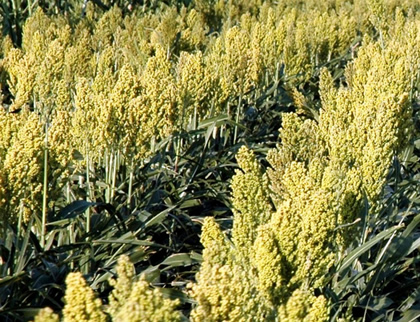 |
| Alternative Grains |
Alternative grains refers to alternatives to high-yield grain crops, the harvest of which has led to severe soil erosion and increased use of fertilizers and pesticides.
More than one-half of the calories consumed daily by humans comes from grains. Most of these grains are produced by plants of the grass family, Poaceae. Major cereal plants domesticated centuries ago include rice (Oryza sativa), wheat (Triticum aestivum), and corn (Zea mays). Other important grain crops, also plants of the grass family, include barley (originating in Asia), millet and sorghum (originating in Africa), and oats and rye (originating in Europe).
Grain Genetics
Since the early twentieth century, the scientific principles of genetics have been applied to improvements of crop plants. Some notable improvements occurred between 1940 and 1970. As a result of irrigation, improved genetic varieties, and the use of large amounts of fertilizers and pesticides, yields of major crops greatly increased.
  |
Norman Borlaug received a Nobel Prize in 1970 for his contributions to these developments, which came to be called the Green Revolution. However, it soon became apparent that the Green Revolution was not the boon first envisioned.
For maximum yield, large-scale farming involving huge capital investment is required. Also, environmentalists became concerned over the erosion and other environmental damage caused by the use of large amounts of fertilizers and pesticides.
Minor Cereals
 |
| Sorghum bicolor |
Various alternatives have been proposed. For grain crops, several approaches offer promise, including more widespread use of minor cereals, especially those tolerant of unfavorable growing conditions; development of new cereal plants by hybridization or other genetic manipulation; and use of pseudocereals, nongrass crop plants that produce fruits (grains) similar to those of cereal plants.
Most sorghum (Sorghum bicolor) grown in the United States is used for silage or molasses. In Africa and India, various grain sorghums are grown in regions where rainfall is too low for most other grain crops.Well adapted to hot, dry climates, their grains are used to make a pancakelike bread.
Millet refers to several grasses that are also useful cereal plants because they tolerate droughtwell. In Africa the most important are pearl millet (Pennisetum glaucum) and finger millet (Eleusine coracana). Grains of both species can be stored for long periods and are used to make bread and other foods.
 |
| Millet field |
Other, perhaps less important, grain plants also called millet include foxtail millet (Setaria italica), native to India but now grown in China; prosomillet (Panicum milaeceum), native to China but grown in Russia and central Asia; sanwa millet (Echinochloa frumentacea), cultivated in East Asia; and teff (Eragrostis teff), an important food and for age plant of Ethiopia. Such grain sorghums and millets have the potential to growin areas with hot, dry climates far beyond the regions where they are now being utilized.
In a distinct category is wild rice (Zizania aquatica). Native to the Great Lakes region of the United States and Canada, it has been, and still is, harvested by American Indians. Like the common but unrelated rice (Oryza sativa), wild rice grows in flooded fields. Attempts to cultivate it since the 1950’s have been somewhat successful as the result of the development of nonshattering varieties.
However, it remains an expensive, gourmet item. Two cereal plants have promise because of the high-protein content of their grains. Wild oat (Avena sterilis) is a disease-resistant plant with large grains. Job’s tears (Coix lachryma-jobi), native to Asia, is now planted throughout the tropics. Research on these and related species continues.
Although all important cereal plants have been improved by genetic techniques, the most notable new alternative grain plant is triticale (Triticosecale). The first human-made cereal, it is the result of crossing wheat with rye. The sterile hybrid from such a cross was made fertile by doubling its chromosomes. Thus, triticale varieties produce viable seeds.
Triticale combines the superior traits of each of its parents: the cold tolerance of rye and the higher yield of wheat. The protein content of triticale compares favorably with that of wheat, and its quality, as measured by lysine content, is higher. However, flour made from triticale is not suitable for making bread unless mixed with wheat flour.
 |
| Triticale |
Pseudocereals
Pseudocereals are plants that are not of the grass family but produce nutritious, hard, grainlike fruits that can be stored, processed, and prepared for food much like grains. They belong to several plant families. Many grow under conditions not suitable for the major cereal crops. Buckwheat (Fagopyrum esculentum), of the Polygonaceae family, probably originated in China.
It tolerates cool conditions and is adapted to short growing seasons, thus permitting it to be grown in the temperate regions of North America and Europe. In the United States, it is often associated with pancakes but is used in larger quantities for livestock feed. In Eastern Europe, the milled grain is used for soups.
Quinoa (Chenopodium quinoa) of the goosefoot family, Chenopodiaceae, has been cultivated by Indians of the Andes Mountains for centuries. The leafy annual produces grainlike fruits (actually achenes) with a high protein content and exceptional quality, high in lysine and other essential amino acids.
After its bitter saponins have been removed, it can be cooked and eaten like rice or made into a flour. Quinoa has been cultivated in the Rocky Mountains since the 1980’s and has become a gourmet food in the United States.
Most amaranths (Amaranthus) plants are New World weeds. They belong to the amaranth family, Amaranthaceae. A few species were used by Aztecs and other North American peoples, but amaranth use was banned by the Spanish.
Since the late 1970’s, plant breeders have targeted several species for improvement. The results are highly nutritious grains, rich in lysine, that are suitable for making flour. Research in Pennsylvania and California has resulted in improved varieties.
